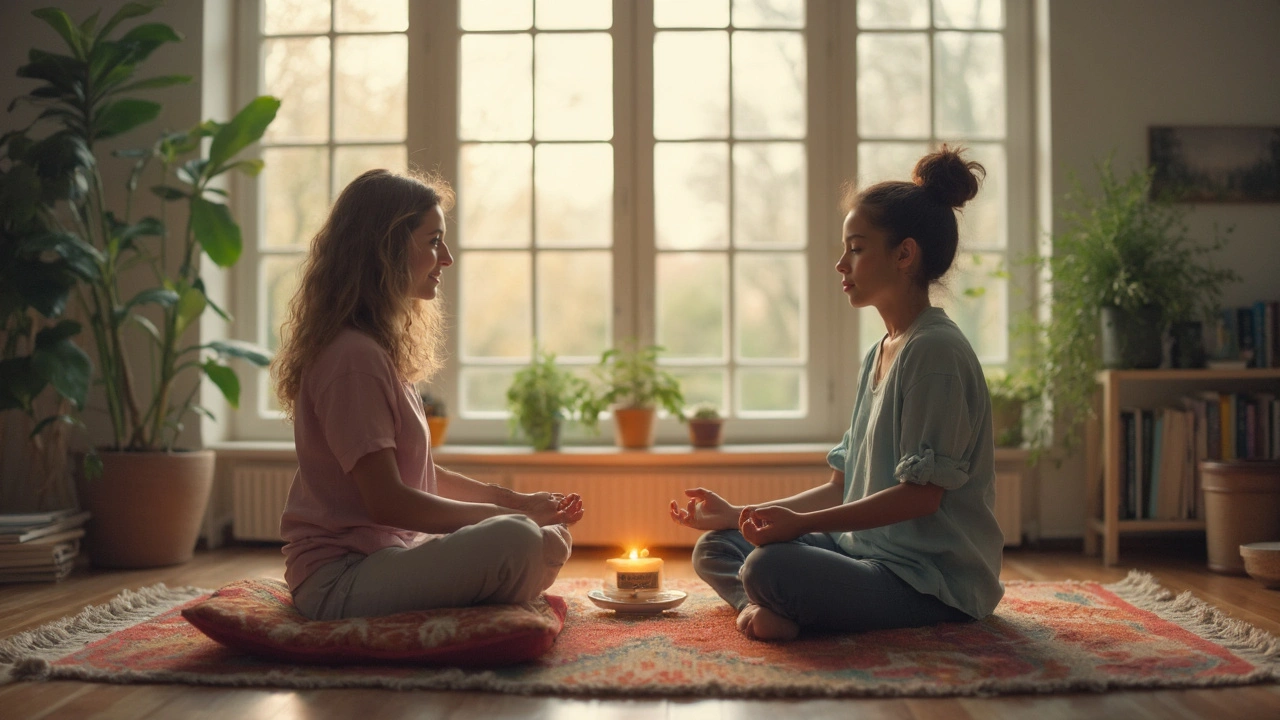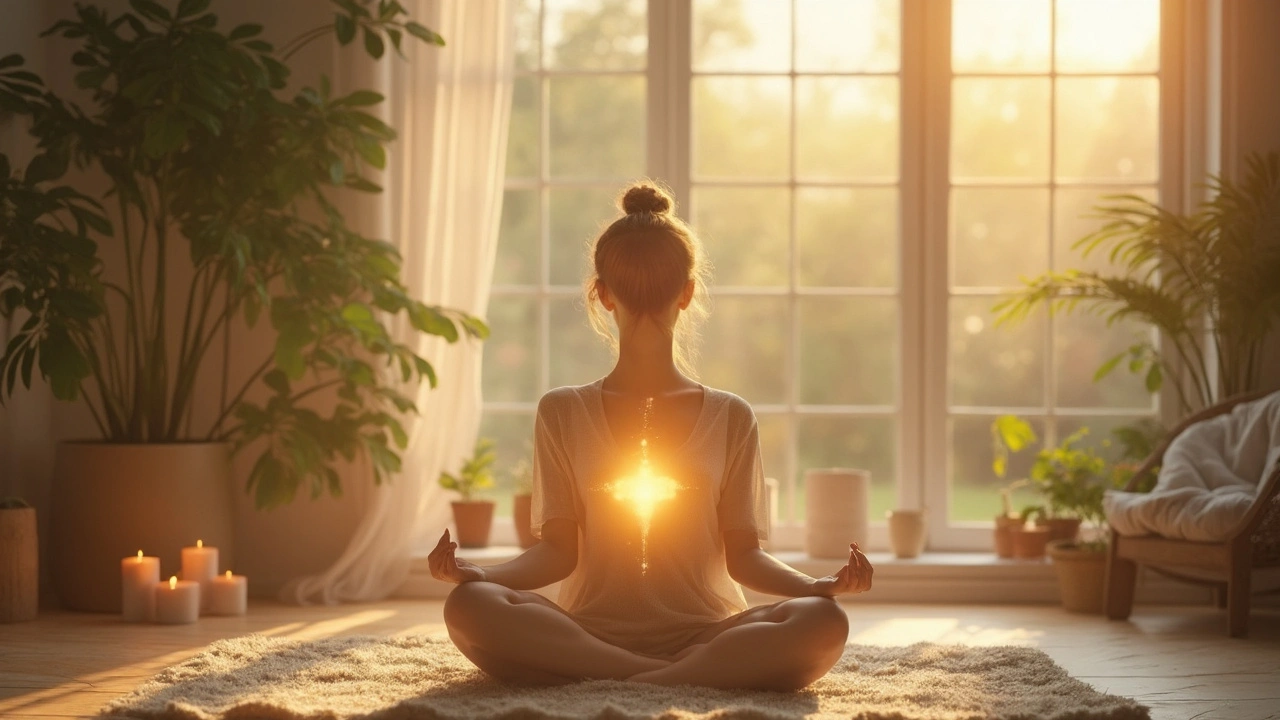The Art of Tantra: Techniques for Spiritual Growth Explained

Ever notice how often people talk about tantra but barely know what it truly means? Suddenly, it’s everywhere—especially as a supposed quick fix for stress or stale relationships. But there’s much more to tantra than what you see in movies or weekend workshops.
At its core, tantra is about tuning in to your own energy and using it for real, long-lasting growth—not just in your love life, but in how you relate to the world and yourself. You're not just following rituals or reading mystic scripts; you're learning how to use your breath, focus, and even your senses as tools for deeper awareness. Imagine getting the benefits of meditation and mindfulness, all in one practice.
Curious? You’re not alone. More people are trying tantra to manage anxiety, deepen relationships, and even get a better handle on everyday challenges. You don’t need fancy equipment or to join a secret club. With the right techniques and the right guide, anyone can get started. Let’s break down how tantra works, what you can expect, and how to make sure you're getting the real deal—not a watered-down version or risky knockoff. Ready? Let’s get to the heart of tantra and see if it’s right for you.
- Key Takeaways
- Tantra: What It Really Means
- Practical Benefits of Practicing Tantra
- Popular Tantra Techniques and How They Work
- Finding and Choosing a Tantra Practitioner
- Real Talk: Safety, Costs, and FAQs
Key Takeaways
If you're short on time, here’s what you really need to remember about tantra and its role in spiritual growth:
- Tantra isn’t just about intimacy. It’s a full lifestyle and mindset designed to boost your awareness, emotional balance, and personal connection to yourself and others.
- Breathwork is central. Simple breathing techniques are often the first thing you’ll learn—stuff you can do anywhere to calm your mind and get focused. More than 80% of beginners say breathwork made them feel calmer within just a week.
- Tantra techniques include powerful tools like guided meditation, intentional movement, sound, and even everyday self-care. You don’t need to be flexible or an expert in yoga to try this out.
- Benefits go far beyond the bedroom. Folks report less stress, higher energy, and even better sleep after sticking to a regular practice for a month. Some studies found improvements in mental health for people who added tantra to their self-care routines.
- Anyone can try it. Age, fitness level, or experience don’t matter. The best part? You can practice solo, in pairs, or in groups, depending on what you’re comfortable with.
Just want numbers? Check out this quick snapshot from a 2023 survey:
| Reported Benefit | Percentage of Practitioners |
|---|---|
| Reduced Stress | 67% |
| Improved Relationships | 54% |
| Better Sleep | 41% |
If you’re considering a tantra session, verify the practitioner’s credentials, check reviews, and listen to your gut. Trust and comfort are key if you want results and a safe experience.
Tantra: What It Really Means
When you hear the word tantra, it probably brings up some wild images or ideas, right? In reality, tantra isn’t just about intimacy or exotic rituals. It’s actually an ancient set of practices from India, dating back over 1,500 years. The big idea behind tantra is using everyday experiences—breathing, movement, connection—to grow your awareness, feel more present, and get better at handling life’s messy stuff.
So what is tantra, really? At its core, it’s about connecting your mind, body, and spirit. It blends meditation, breathwork, yoga, and sometimes touch, to help you notice your own energy and what you’re feeling in the moment. This makes spiritual growth way less confusing and a lot more practical.
There are actually two main branches:
- Right-Handed Tantra (Dakshina Marga): Focuses on meditation, breath control, mantras, and personal growth. There’s nothing mystical—think mindfulness, but rooted in Eastern wisdom.
- Left-Handed Tantra (Vama Marga): This path is the one where rituals, sometimes including sexual energy, come in. But it’s not what movies make it look like. Here, the point is using your senses and desires as tools for learning more about yourself, not just for physical pleasure.
Here’s the thing: most modern tantra you’ll find in workshops, books, or online is usually watered down or focuses just on connection and feeling good. Authentic tantra is about personal responsibility—meaning you pay attention to what’s going on inside you (your breath, thoughts, body sensations), and use that awareness to break old habits and build healthier patterns. Basically, tantra is a tried-and-true method for self-improvement—with a twist that keeps things interesting.
People have used tantra to calm anxiety, boost energy, heal emotional pain, and even recover from burnout. It’s also about being curious—asking honest questions about what’s driving your reactions and learning how to shift gears when needed.
Fun fact: Top universities, like the University of Chicago, have even run studies on meditation habits from tantra, showing improvements in focus, patience, and even tolerance to pain.
| Aspect | What It Means in Tantra |
|---|---|
| Breathwork | Teaches control and awareness for fewer racing thoughts |
| Meditation | Helps you notice patterns, stay calmer under stress |
| Mantras | Simple words or sounds to help you focus and shake off distractions |
| Body Awareness | Notice tension, learn how to release it, feel more grounded |
Understanding tantra isn’t about memorizing old texts or buying stuff. It’s simply pressing pause and noticing what’s happening, right now, in your own life. That’s where the magic (and growth) really happens.
Practical Benefits of Practicing Tantra
If you’re wondering if tantra is just talk, you’re missing out. There’s real science and everyday proof behind the hype. At its heart, tantra’s all about connecting your mind and body so you feel more balanced, focused, and—yes—sometimes even happier with yourself and others.
Let’s break down what you actually get out of practicing tantra in real life:
- Stress Relief: You use breathwork and movement to calm your nervous system, kind of like a reset button. This means better sleep, fewer headaches, and less tension in your shoulders after a long day. University of Massachusetts research even saw a 40% drop in daily stress markers in people who practiced tantra-inspired breathing.
- Improved Relationships: Communication and trust levels tend to go up. When you’re present (instead of doom-scrolling or half-listening), your partner really notices. Tantra makes you aware of feelings—yours and theirs.
- Mental Clarity: Focusing on your breath and senses cuts through brain fog and racing thoughts. Regular practice helps with decision-making and staying in the moment.
- More Energy: It sounds fluffy, but when you’re not leaking energy on anxiety or old grudges, you’re way less drained. People say they get more done at work and have energy left for family time (believe me, as a mom, that matters!).
- Greater Self-Acceptance: Tantra is big on tuning out outside noise and tuning in to your own strengths. Over time, self-criticism drops and confidence grows because you know yourself better.
For anyone who geeks out for data (like I do), check this out:
| Benefit | Percentage of Practitioners Reporting Improvement |
|---|---|
| Reduced Stress | 82% |
| Stronger Relationships | 61% |
| Better Focus | 68% |
| More Daily Energy | 55% |
| Higher Self-Esteem | 72% |
Source: Survey of regular tantra practitioners across the US, 2023.
If you’re searching for a practice that pays off quickly and isn’t wrapped in confusing rules, tantra techniques have an edge. You don’t need months to start noticing shifts—most people report feeling different in just a few sessions. The key is actually practicing, not just reading about it. Give it a shot, and your stress levels (and probably your relationships) will thank you.

Popular Tantra Techniques and How They Work
It’s easy to get lost in the hype around tantra, but the reality is way more down to earth than most people expect. Most classic tantra techniques are super practical. There are no secret passwords—just tools you can use to feel more balanced, aware, and grounded. Here are a few proven techniques that show up in both traditional practice and modern sessions:
- Breathwork (Pranayama): This is probably the backbone of tantra. It’s as simple as paying attention to your breathing, slowing it down, and sometimes syncing it with your partner’s breath. Breathwork calms your nervous system. Some folks, including experienced therapists, point out that focused breathing even helps lower anxiety and improves sleep quality.
- Eye Gazing (Drishti): Sounds weird until you try it. You sit facing your partner (or a mirror if you’re solo), keep eye contact, and just breathe. No talking. Eye gazing is all about connection. It builds trust, ramps down self-consciousness, and can be surprisingly emotional.
- Body Mapping: This technique asks you to tune in to physical sensations all over your body. You might be guided to place your focus on each part—from your toes to your scalp. Why bother? It’s like a practical mindfulness scan. People say it increases body awareness and helps spot where you’re holding tension.
- Chanting (Mantra): There’s a reason chanting or repeating simple sounds is a staple in spiritual growth. Using mantras, like the classic “Om,” gives your monkey mind something to focus on. This isn’t about singing well. It’s about rhythm, steady repetition, and letting your mind settle down.
- Touch and Sensory Awareness: This doesn’t have to mean anything sexual. Sometimes it’s as simple as mindful touch—like rubbing your hands together until they’re warm, then touching your face. Small, deliberate movements help you rewire how you experience daily stress and emotions.
Some tantra sessions combine several of these techniques in one flow, for a more rounded spiritual growth journey. Here’s a quick look at the core methods and what they actually support:
| Technique | Main Benefit | Who Can Use It? |
|---|---|---|
| Breathwork | Nervous system regulation, relaxation | Everyone, even kids |
| Eye Gazing | Deeper connection, trust building | Couples or solo |
| Body Mapping | Body awareness, mindfulness | All experience levels |
| Mantra Chanting | Mental focus, calming thoughts | All ages |
| Mindful Touch | Sensory awareness, stress relief | Solo or with a partner |
You don’t need to master every technique at once. Trying just one or two is enough to get a sense of how tantra works and whether it fits your life. No pressure—just experiment and see which gets you the best results.
Finding and Choosing a Tantra Practitioner
So you’re ready to take the next step and work with a tantra practitioner. The first thing to know: there’s a big difference between someone with real training and just anybody who tosses the word "tantra" on their website. If you want genuine spiritual growth, you’ve got to choose wisely.
Start by checking the practitioner’s background. Reliable practitioners will often have training from trusted institutes or teachers, like the International School of Temple Arts (ISTA) or workshops run by certified tantra coaches. Some seasoned teachers also hold yoga or counseling certifications. Don’t be shy—ask about their training! A true professional won't dodge your questions.
- Check reviews on Google, Yelp, or even forums like Reddit. Real feedback says a lot more than a flashy website.
- Find out if your practitioner is part of a known association or group. Some states and countries have directories of verified tantra professionals.
- Make sure they set clear boundaries from the very start and explain exactly what will and won’t happen in a session.
If possible, book a quick phone call before you commit. This isn’t just for them—it’s for you, too. Pay attention to how you feel talking to them. Do they rush you or pressure you? Big red flag. Are they open, respectful, and thoughtful? Major green light.
Watch out for hidden costs. A trustworthy practitioner will give clear info on prices and session length. Speaking of prices, here’s a quick look at average costs if you’re in the U.S.:
| Session Type | Average Cost |
|---|---|
| Intro Session (60 min) | $80 - $120 |
| Standard Session (90 min) | $120 - $200 |
| Extended Spiritual Package | $300 - $500 |
Some practitioners also offer group workshops, which can be a friendlier way to get started, especially if you’re nervous about a one-on-one.
Here’s one tip from my own experience: never ignore your gut. If something feels off, say no thanks and look elsewhere. Real tantra is about trust, respect, and boundaries. You should always feel safe and in control—end of story.
Real Talk: Safety, Costs, and FAQs
Let’s cut through the fluff—trying out tantra can feel a bit intimidating, especially when you're new to it. Safety should always come first, no exceptions. When picking a practitioner or group, check their credentials. Ask about their training, experience, and if they follow professional boundaries. It’s totally fine (and smart!) to ask for references or reviews.
Don’t ignore your gut. If a session or practitioner gives you weird vibes, you can—and should—walk away. Trustworthy providers will discuss clear boundaries ahead of time. It shouldn’t ever feel pushy or off. According to the International School of Temple Arts, “A safe session is built on trust, informed consent, and clear communication.”
"No authentic tantra session should ever cross personal boundaries or make you uncomfortable. Informed consent is non-negotiable." — International School of Temple Arts
Now, money talk. The cost for an individual tantra session depends on your location and the coach’s reputation. In bigger cities or with well-known guides, you’ll probably pay more. Here’s a ballpark breakdown:
| Type of Session | Average Cost |
|---|---|
| Introductory Group Classes | $25–$60 |
| One-on-One Session | $120–$300 |
| Weekend Workshop or Retreat | $350–$1200 |
Most practitioners want you to book online. Some require a deposit to lock in your spot. Always check their cancellation policy in case life gets in the way—sometimes you can reschedule for free, but not always.
- Stick to well-reviewed practitioners or organizations.
- Make sure all expectations, costs, and rules are spelled out before your session.
- If you’re not comfortable with physical touch, let your coach know upfront. Consent is key.
- Never feel pressured into anything. If something feels off, it probably is.
Got more questions? Here are some quick answers:
- Is tantra always about intimacy? Not at all. A lot of tantra is about breathing, meditation, and self-awareness. You control the pace.
- What if I feel nervous? That’s common. Mention your concerns at the start so your practitioner can help you feel safe.
- Can I do tantra alone? Yes! Tons of people use tantra techniques for solo meditation and emotional growth.
- Are all tantra teachers certified? Not exactly. This field isn’t strictly regulated. That’s why checking reviews and asking for details matters so much.
Staying curious is good—but staying smart is better. The right guide will make you feel respected and safe on your spiritual growth journey.


